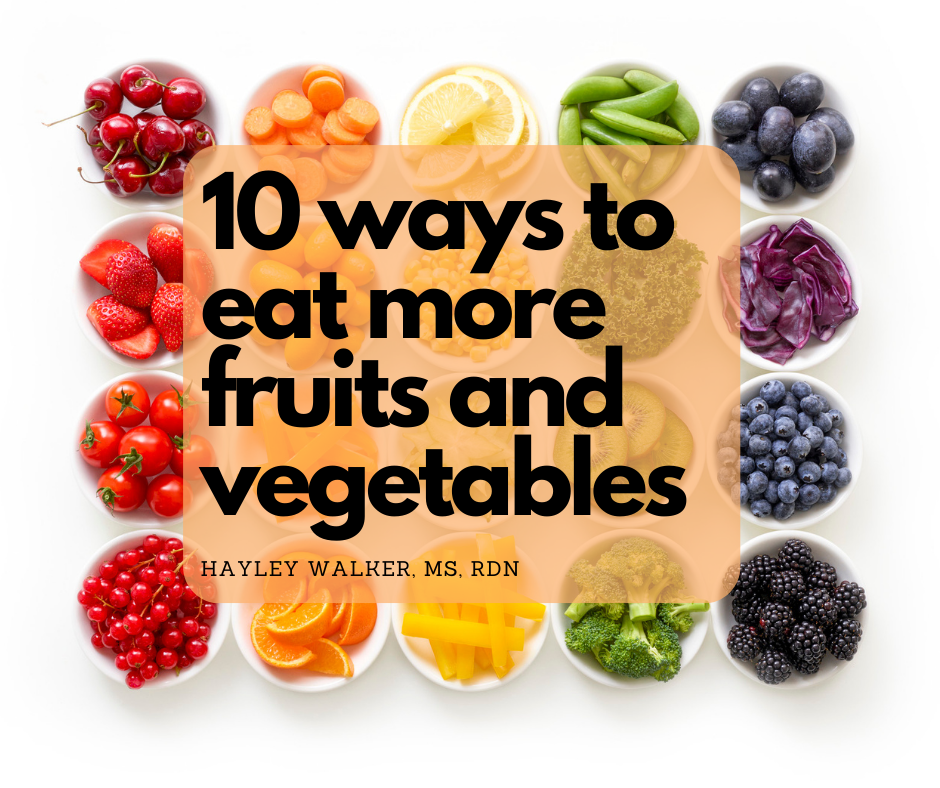
In honor of National Nutrition Month (March), it’s appropriate to discuss some methods to incorporate more fruits and vegetables into your diet. Why? Fruits and vegetables are a part of a healthy, balanced plate which includes: lean proteins, complex carbohydrates, fruits, vegetables, and dairy. They support a healthy diet in a multitude of ways including keeping you full for longer periods from a richness in fiber, improving your gut health and function, helping lower cholesterol, and improving blood pressure – just to name a few. They also contain different vitamins and minerals based on their colors. For instance, sweet potato is a great source of vitamin A while white potato is a great source of potassium.
For these reasons and more, it is recommended that half of your plate be fruits and vegetables – that’s about 2 cups of fruit and 2 ½ cups of vegetables per day. Despite this recommendation only about 12% of adults are meeting their fruit recommendation and less than 10% are meeting their vegetable recommendations. Interestingly enough, so many people that come to meet with a dietitian talk about their desire to make healthier choices yet have the same complaint. They buy fruits and vegetables that end up going bad or they simply don’t want to buy them at all knowing they may go to waste.
So, what can we do about this? Well . . . I have some ideas to help you stretch your food budget, use the fruits and vegetables you buy, and possibly create sustainable habits for including produce.
- Plan several meals using one fruit or vegetable. If you are using a couple of stalks of celery in one recipe, consider using the rest of the celery in another recipe or as a substitute to enjoy with dip as a snack.
- Bump up the volume! Adding mild-flavor vegetables to soups, sauces, or smoothies is a great way to increase your intake. Add a bag of coleslaw mix to a soup or throw a handful of spinach or cauliflower into your smoothie for little impact to flavor while getting more veggies and fiber.
- Plan it out. Plan fruits and vegetables into your weekly meals. When developing a meal plan, do your best to balance what you’re making with well-paired produce. You may even peruse what’s in season (and likely on sale) to help drive what you decide to make.
- Prep your produce ahead of time. Take the time to clean, cut and store fruits and vegetables so that they are easy to grab during the week when you want a snack.
- Add, don’t take away. Instead of substituting altogether or opting away from produce, try incorporating it. For instance, try some carrot sticks in addition to chips when eating a sandwich or salsa. Or try sprucing up ice cream with fresh berries in addition to some chocolate.
- Keep it in sight. Keeping fruits and vegetables on your counter, at eye-level in your refrigerator and easily accessible within a pantry helps visually remind us of these options when we crave a snack.
- Convenience is key. Buy fruits and vegetables that are in season (therefore less likely to spoil), try frozen options (preferably without added ingredients) or even look at canned produce without added sugar or sodium.
- Make it the focus. Cast fruits and veggies as the star of your meal! We often think of them as supplementary but there are many dishes where produce is the main dish. A couple of examples include bananas with Greek yogurt or vegetable soup with whole grain bread.
- Stock your freezer. Stock up with veggies to steam in a pinch or add to a meal as a quick side.
- Make it pretty. Things tend to be more appetizing when they look appealing to you. The vibrant color of produce is naturally pleasing to the eye. Try “eating the rainbow” and displaying a variety of colors on your plate.
I hope this list includes one or two methods to help you increase your consumption of fruits and vegetables. You may just find that through the variety of flavors, textures and natural health benefits, you find some new favorite foods in the process!





